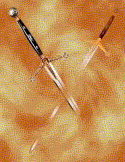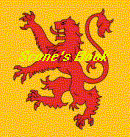

 |


Scone's Scottish and Celtic Internet Book
Scottish Highlands and Islands Partnership
History of Clan Wallace
Scottish History and Culture
www.sconemac.com
www.sconemac2.com
www.clangunn.com
www.clangunn.net
 |

~~{ by Sconemac}~~
 |
"For Liberty We Hope"
Clan Wallace is for obvious reasons, one of the greatest, if not the greatest Clan History from Scotland, because of Scotland's Hero, William Wallace, Guardian of Scotland, defender of the freedom of Scotland.
This Clan has no Septs (or family members) just Wallace, this is the current Chief's decison.
Clansmen's Crest: A dexter arm in armour, embowed, in hand a sword, all proper.
Motto: Pro Libertate Sperandumest (For liberty we hope).
Gaelic Name: Uallas
Origin of Name: from Volcae, a tribe in North Gaul also a Welsh name Wallenis from Wales, and the Lowlands also claim him.
In the old Latin documents the term Wallenis, or Walenis, was used to designate the Welsh, but in Scotland it was used more particularly to designate the Britons of Strathclyde who were of the same stock. From this came the name Wallace.
Richard Wallace, in the 12th century, obtained extensive lands in Aryshire, in the district now known as Riccarton. His son Henry Walays acquired lands in Renfrewshire and his decendant Sir Malcolm Wallace of Elderslie was the father of Scotland's greatest patriot, Sir William Wallace, who was his second son.
In his early years Wallace and his mother had to take refuge near Dunipace from the English, for the Wallaces' refused to do homage to Edward I. While still very young, Wallace was the leader of a company of patriots, and his harassing tactics against the English earned for him the support of many nobles. His reprisal against the garrison at Lanark for the murder of his sweetheart, Marion, and the burning of the "barns of
Ayr" in revenge for the murder of his uncle and other gentlemen who had been invited to a conference, gained him still more supporters.
His military genius made him hated and feared by Edward I, and his only defeats were brought about by the jealousies and treachery of nobles forming his own armies, yet somewhat loyal to Edward I. He was ca[tired bu treachery he was captured at Robroyston, near Glasgow, and
delivered to Edward I, by Sir John Menteith. To remember this traitors dastardly deed of turning Wallace over to Edward I, the only lake in Scotland is named after him, "so we never forget". That is the only lake in Scotland, the rest are Lochs. Wallace was brutally excecuted (drawn and quartered); his head impaled on the Tower of London; his body cut into four pieces. His arms, and legswith torso sections were distributed to the four corners of Scotland - to show the defiance of Edward I, (in 1305), but by his (Wallace's) example it kindled a spirit of independence in Scotland that was never extinguished. The Wallaces of Craigie, of Cessnock, of Kelly, and of Cairnhill were all descended from the original family of Riccarton in Aryshire. Due to the fact that Wallace's history has been so changed, added to, deleted, changed around, I am asking Skyelander, Robert Gunn, (historian), to add to this clan history, the Concise History of Wallace, with some explanation of the facts in Braveheart the movie. With permission
of Robert Gunn, Medieval Historian, and author I will post his history with my Clan Wallace history, so that the true facts will be here for Wallace people and all Scots. All that is written about Wallace, was written by Blind Harry, or Blind Hary, a bard, who wrote it 200 years after Wallace's death, so it is hardly accurate, and most likely expanded upon. Nancy MacCorkill,F.S.A. Scot
Author, Poet
Clans Gunn, MacLeod of Lewis, and Keith(Marshall).
Historian of the Ancient Clans of Scotland
Copyright "©All Rights Reserved May 5, 1998, THRU 2003 by ©N.A.MacCorkill
©Copyright: no reproductioons, copies nor any form of media, or communication, storage or retrieval media ssystems, and as a part of ©Scone's Scottish and Celtic Internet Book, all material inclusive", is copyrighted!© Not public domain.
 |
From the desk of -- Robert Gunn, M.A. (Skyelander) [1]A brief look at the life/battles of Sir William
Wallace: Wallace was born in Ellerslie, near Paisly in Scotland. His father was a Malcolm Wallace and Wallace had two brothers, John and Malcolm and possibly a sister. He was born around 1272. His early life is truthfully mostly unknown and most of what we think we know about his life is based on an oral poem by the minstrel Blind Hary, who told people of Wallace 200 years after Wallace was dead...so, much of it is legend. Wallace did kill the Sheriff of Lanark to avenge the killing of his wife or girlfriend (no one is sure if he was married to her or not) Her name is thought to have been Marion Braidfute, (not Murron MacClannough). After he killed the sheriff (de Hazelrig), Wallace began to attract a following of loyal men who also wanted the English presence out of Scotland. He was a commoner or a minor noble, and never really had the support of the Major nobles, like Robert the Bruce. Balliol or "Red" John Comyn, (all of Norman descent). Wallace's name suggests his relatives were originally from Wales or from the Strathclyde British area of Scotland. He did have some other minor nobles that fought with him, in particular a Sir Andrew de Moray, (later called Murray), who was his loyal friend and right-hand man. De Moray was skilled in warfare and was instrumental to Wallace in his victory at Stirling bridge. Stirling Bridge::::(1297) The battle was fought by a narrow Bridge, Stirling Bridge, not in an open field as in Braveheart, (the movie). The English army, under the command of the Earl of Surrey (John de Warrenne) and the High Justicar of Scotland (Hugh de Cressingham). The English attempted to cross the narrow bridge two horsemen at a time and as they began to gather on the Scottish side of the bridge, Wallace charged and de Moray also charged, trapping the English mounted knights in a closed pincer movement. The English, at the other end of the Bridge could only watch on helplessly as the Scots pulled the English
knights from their horses and slaughtered them. It was a complete victory for Wallace. Unfortunately, his right hand man and good friend, Sir Andrew de Moray (not Mornay as in the movie, that Mornay was fictional), was mortally wounded and died days later. Wallace now had to continue the fight without
his best friend and best strategist. Wallace never had a love affair with the princess of England, Isabella. She was only 7-9 years old at the time. This was
"Hollywood's artistic license", for the movie. Also Edward I "Longshanks" was even more vicious than portrayed (IMO) in the movie. His son, Edward II was indeed Gay, and never loved women. His own men killed him, when he took over after Edward I's death. After Wallace won the battle at Stirling, he was knighted and was given the title of "Guardian of Scotland", and many say it was Robert the Bruce himself, who knighted Wallace, (however this is not proven). Falkirk: In 1298, Edward I, returned to England and led an army north again to Scotland, to find and destroy Wallace's army. During the ride north, Edward's new Welsh archers, got into a killing fight with the English soldiers, and nearly broke up the whole invasion force, but Edward I managed to restore calm, and went forth to Falkirk to meet Wallace. Wallace had just adopted a new tactic for fighting heavy cavalry attack. The Scots had 'light horsemen', however, not as many as the English 'heavy mounted knights'. Wallace was outnumbered nearly six to one. Wallace's new tactic (schiltron)was long (twelve foot, 'heavy' spears). Speared units of massed infantry, formed into box or oval shapes. They fought by using the reach of the spears to impale the charging English knight's horses. Once they were unhorsed, the knights were pulled aside and killed. It was devastatingly effective. They were called "schiltrons" pronounced skil-trons. By a twist of fate, Edward I also came to Falkirk with a new battle tactic. He decided from his experience in Wales, to employ the Welsh archers in mass units to shower the enemy with arrows. When the battle was met, Wallace looked out over the thousands of English knights and archers and saw his peril. He said to his men "I haif brocht ye to th' ring, hop gif ye can!" (meaning, in essence, good luck and fight well). He fought in the front ranks with his men swinging a large two handed sword. He was apparently a very tall man by all accounts. At first, the battle was going poorly for the English. Edwards I's younger knights, anxious to prove themselves, galloped full force into Wallace's Schiltron units, the speared units held and Edward lost many, many young knights that day. Wisely, though, Edward I, saw the danger and called back his mounted knights, and brought up the massed units of Welsh archers. They fired shower upon shower of longbow arrows on Wallace's tightly packed schiltron units and eventually, the schiltrons were weakened effectively enough for Edward's Knights to charge the enemy. About this time, some 10,000 of the Scots (mostly the mounted warriors) led by "Red" John Comyn; a rival of Robert the Bruce; quit the field and led his contingent of 10,000 horsemen and infantry off the field. Wallace had been betrayed! Eventually the combination of Welsh longbows and charging English cavalry were too much for the Scots and they were slaughtered on the field. Wallace managed to escape, and went into hiding for years. He resigned as "Guardian of Scotland" and went into a deep depression for his men and his plight. He was generally unseen and unknown by the rest of Britain for the next 6 years, and in 1305, he was betrayed by a minor noble named Sir John Menteith, who knew Wallace, and arranged for Wallace's capture while he was sleeping. Menteith captured Wallace, (not Robert Bruce as portrayed in the movie), and took him to England to be executed. Wallace stated to the Chief Royal Judge that he had never pledged loyalty to Edward I, so how could he be guilty of treason? Darn good question, but the English didn't see it that way and sentenced Wallace to be "hung, drawn and quartered". The execution was carried out 23rd August 1305. Wallace was hung by the neck, cut down while still alive, then he was "drawn", which means he was cut open in the abdomen; disembowled and his intestines burnt before his eyes. Then, finally, he was beheaded and cut into four sections. His head was placed on London Bridge to rot. His four body sections were sent to the four major cities in southern Scotland. I've given this brief description, it is just a quick outline of Wallace and his major battles, not an in-depth look at Wallace the man. To read 'The Battle of Stirling Bridge'; 'The Battle of Falkirk' and more about Wallace see my history web page shown on this web sites link page. Robert Gunn, M.A.
I hope you enjoy my Clan Wallace History, and the insightful article about Clan Wallace by R. Gunn.
[2](with brief explanations of some 'facts' presented in the movie "Braveheart".
Skyelander,
October 1996 RMG. "All Rights Reserved 1996-97, THRU inclusive 2003 R.Gunn."
 |
Page ©copyright, "in whole, or in part as ©Scone's Scottish and Celtic Internet Book, |
